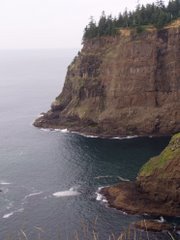 Check out this article on solar tower technology in Spain. It's one of the better advanced power technology options I've seen lately.
Check out this article on solar tower technology in Spain. It's one of the better advanced power technology options I've seen lately.This looks like something as a viable option in the American southwest, where there's a reliable amount of sunlight---it would be great to see Big Oil do something positive for the environment, for a nice change of pace, and invest in something like this.
...but what am I thinking. Of course, that idea would be all too easy and actually make sense. S
There is a scene in one of the Austin Powers films where Dr Evil unleashes a giant "tractor beam" of energy at Earth in order to extract a massive payment.
Well, the memory of it kept me chuckling as I toured the extraordinary scene of the new solar thermal power plant outside Seville in southern Spain.
From a distance, as we rounded a bend and first caught sight of it, I couldn't believe the strange structure ahead of me was actually real.
A concrete tower - 40 storeys high - stood bathed in intense white light, a totally bizarre image in the depths of the Andalusian countryside.
The tower looked like it was being hosed with giant sprays of water or was somehow being squirted with jets of pale gas. I had trouble working it out.
 In fact, as we found out when we got closer, the rays of sunlight reflected by a field of 600 huge mirrors are so intense they illuminate the water vapour and dust hanging in the air.
In fact, as we found out when we got closer, the rays of sunlight reflected by a field of 600 huge mirrors are so intense they illuminate the water vapour and dust hanging in the air.
The effect is to give the whole place a glow - even an aura - and if you're concerned about climate change that may well be deserved.
But ultimately, the entire plant should generate as much power as is used by the 600,000 people of Seville.
It works by focusing the reflected rays on one location, turning water into steam and then blasting it into turbines to generate power.
As I climbed out of the car, I could hardly open my eyes - the scene was far too bright. Gradually, though, shielded by sunglasses, I made out the rows of mirrors (each 120 sq m in size) and the focus of their reflected beams - a collection of water pipes at the top of the tower.
It was probably the heat that did it, but I found myself making the long journey up to the very top - to the heart of the solar inferno.
A lift took me most of the way but cameraman Duncan Stone and I had to climb the last four storeys by ladder. We could soon feel the heat, despite thick insulation around the boiler.
It was like being in a sauna and for the last stages the metal rungs of the ladders were scalding.
But our reward was the cool breeze at the top of the tower - and the staggering sight of a blaze of light heading our way from down below.
So far, only one field of mirrors is working. But to one side I could see the bulldozers at work clearing a second, larger field - thousands more mirrors will be installed.
I met one of the gurus of solar thermal power, Michael Geyer, an international director of the energy giant Abengoa, which owns the plant. He is ready with answers to all the tricky questions.
What happens when the Sun goes down? Enough heat can be stored in the form of steam to allow generation after dark - only for an hour now but maybe longer in future.
Anyway, the solar power is most needed in the heat of summer when air conditioners are working flat out.
Is it true that this power is three times more expensive than power from conventional sources? Yes, but prices will fall, as they have with wind power, as the technologies develop.
Also, a more realistic comparison is with the cost of generating power from coal or gas only at times of peak demand - then this solar system seems more attractive.
The vision is of the sun-blessed lands of the Mediterranean - even the Sahara desert - being carpeted with systems like this with the power cabled to the drizzlier lands of northern Europe. A dazzling idea in a dazzling location.
By David Shukman
Science correspondent, BBC News, Seville

















2 comments:
THAT IS COOL!!
It's too bad we didn't do it first.
Yeah, it seems like it could be successful in Colorado and the entire SW part of the country.
Heck, with funding and a few more minor technological tweaks or advancements, we could - and should - be harnessing enough sunlight there to power the entire nation!
Unfortunately, in some ways I think we need gas prices to sky rocket, and the system to implode, in order to get there.
Post a Comment